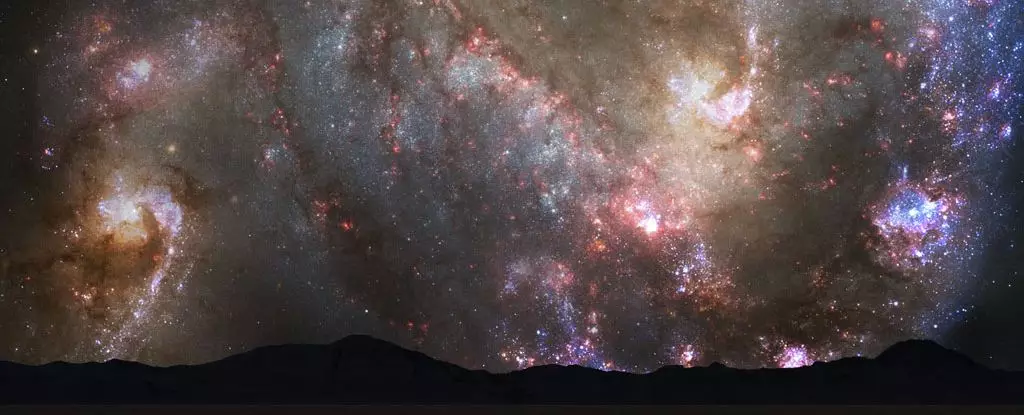Astrophysics continuously challenges our understanding of the universe, especially concerning the destinies of celestial bodies. One riveting storyline involves a potential collision between the Milky Way and Andromeda galaxies, a scenario that has sparked both awe and trepidation. Recent investigations, spearheaded by University of Helsinki astrophysicist Till Sawala and his team, inject new complexity into this cosmic narrative. Their analysis reveals that we are far from a definitive fate regarding a collision; instead, there exists a near 50% chance the two galaxies may avoid each other altogether. This revelation serves as a reminder of the unpredictable nature of cosmic events and raises questions about our grasp of the universe’s vast complexities.
Rethinking the Inevitable Collision
For years, the notion of “Milkomeda”—the anticipated merger of the Milky Way and Andromeda—has been treated as almost a foregone conclusion within the astrophysical community. The timeline suggested for this merger hovered around 4.5 billion years. However, the recent findings from Sawala’s team challenge this outlook, suggesting that previous calculations remain valid, yet they represent only one of myriad cosmic possibilities. The significance of these calculations lies not merely in the possibility of merger but shines a light on a spectrum of outcomes that could unfold based upon the relative positions and movements of other nearby galaxies.
The team’s efforts involved a meticulous process where data from groundbreaking instruments, like the Hubble and Gaia space telescopes, were employed. By modeling the gravitational interactions between the Milky Way, Andromeda, Triangulum galaxy, and the Large Magellanic Cloud, they oscillated between different cosmic configurations, thereby gaining nuanced insights into their fates. This demonstrates a level of sophistication in cosmic modeling that was previously overwhelmed by straightforward predictive binaries.
A Galaxy’s Three-Dimensional Complexities
One particularly intriguing aspect of Sawala’s research is how it underscores the unpredictability inherent in multi-body gravitational systems. While it may be tempting to imagine galaxies as solitary wanderers on a two-dimensional plane, they exist within a radically three-dimensional context teeming with variables. Each additional galactic player in the Local Group modifies the gravitational dynamics substantially. What might appear straightforward in vacuum scenarios quickly unravels into a quagmire of complexities when other cosmic bodies exert their gravitational influence.
In controlled scenarios devoid of neighboring galaxies, the collision probability stands slightly under 50%. Introducing M33 enhances this likelihood to about 67%, whereas replacing M33 with LMC reduces it to roughly 33%. These findings encapsulate the chaos and dynamism in our cosmic neighborhood, revealing that the fate of two galaxies can hinge remarkably on the presence or absence of a third entity.
Peering into the Cosmic Future
Sawala’s research astutely emphasizes that galactic fate is not predestined. Rather, it is an ongoing interplay of forces that can only be surmised with increasing accuracy through time and technological advancements in observational capacity. The study recognizes that while there is progress in data acquisition, uncertainties remain. As scientists continue to refine their tools for cosmic measurement, like the next-generation telescopes, higher accuracy in predicting galactic behaviors will emerge. However, the reality remains that the farther we gaze into the cosmic future, the more elusive definitive answers become as unpredictable elements continually enter the equation.
Sawala musingly reflects on this fascinating uncertainty, noting the importance of delving beyond our historical emphasis on and understanding of the past. For him, contemplating galactic destinies opens a portal into the untold narratives of cosmic evolution, broadening the scope of astrophysical inquiry beyond the constraints of traditional frameworks.
Implications of Galactic Mergers
The broader implications of potential collisions such as that between Milky Way and Andromeda extend to our understanding of galaxy formation and evolution. Certain models suggest that the merging of galaxies can result in starbursts—periods of intense star formation—primarily due to gravitational interactions stimulating gas clouds. Such cosmic events could reshape the galaxies involved and indeed impact the very structure of the Local Group. Should our local giants eventually merge, the newly formed galactic entity may emerge as a vibrant new oasis in our universe.
In navigating the vast uncertainties of cosmic encounters, scientists must cultivate a deep appreciation for complexity. As new astronomical instruments come online and provide fresh insights into the cosmos, we stand at the precipice of a greater understanding not only of our galactic neighborhood but also of the unfolding narrative of the universe at large. The realization that the potential for cosmic collisions remains a significant yet uncertain aspect of our understanding serves as an invitation to ponder the multifaceted, intricate tapestry of cosmic destiny.

